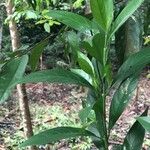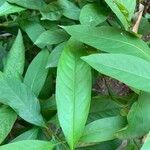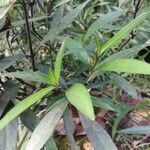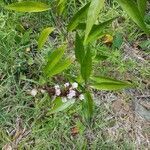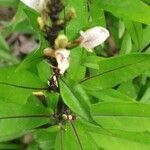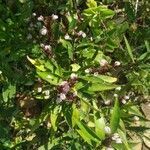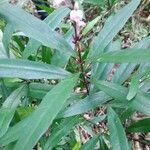| Therapeutic use
|
Analgesics (aerial part), Anti-inflammatory agents (aerial part), Cough (bark), Emetics (bark), Cough (flower), Eye pain (flower), Analgesics (leaf), Anti-bacterial agents (leaf), Anti-infective agents, local (leaf), Anti-inflammatory agents (leaf), Antipyretics (leaf), Antirheumatic agents (leaf), Asthma (leaf), Beriberi (leaf), Bronchitis (leaf), Colic (leaf), Common cold (leaf), Cough (leaf), Dysentery (leaf), Earache (leaf), Eczema (leaf), Edema (leaf), Emetics (leaf), Facial paralysis (leaf), Fractures, bone (leaf), Furunculosis (leaf), Headache (leaf), Hemiplegia (leaf), Hemorrhage (leaf), Hemostasis (leaf), Insecticides (leaf), Joint diseases (leaf), Leukorrhea (leaf), Lymphadenitis (leaf), Measles (leaf), Migraine disorders (leaf), Mouthwashes (leaf), Neoplasms (leaf), Neuralgia (leaf), Nasal disease (leaf), Paralysis (leaf), General tonic for rejuvenation (leaf), Smallpox (leaf), Wounds and injuries (leaf), Antiperiodic (leaf), Diaphoretic (leaf), Antidepressive agents (root), Anti-infective agents, local (root), Anti-inflammatory agents (root), Antipyretics (root), Antirheumatic agents (root), Cough (root), Dysentery (root), Dyspepsia (root), Fever (root), Leukorrhea (root), Anti-poisoning (root), Ulcer (root), Diaphoretic (root), Kidney calculi (seed), Toothache (seed), Antirheumatic agents (shoot), Earache (shoot), Antioxidants (stem), Liver diseases (stem), Ache(Ear) (unspecified), Amenorrhea (unspecified), Bite(Snake) (unspecified), Carminative (unspecified), Colic (unspecified), Debility (unspecified), Diaphoretic (unspecified), Diarrhea (unspecified), Diuretic (unspecified), Dysuria (unspecified), Emetic (unspecified), Emmenagogue (unspecified), Fever (unspecified), Hemicrania (unspecified), Insecticide (unspecified), Jaundice (unspecified), Marasmus (unspecified), Numbness (unspecified), Rheumatism (unspecified), Spasm (unspecified), Stomach (unspecified), Styptic (unspecified), Evil eye (unspecified), Lunacy (unspecified), Anodyne (unspecified), Beri-Beri (unspecified), Carbuncle (unspecified), Cephalgia (unspecified), Edema (unspecified), Intermittent Fever (unspecified), Paralysis (unspecified), Refrigerant (unspecified), Sedative (unspecified), Cough (unspecified), Gastrosis (unspecified), Gonorrhea (unspecified), Headache (unspecified), Malaria (unspecified), Myalgia (unspecified), Renosis (unspecified), Swelling (unspecified), Thrush (unspecified), Hematoptysis (unspecified), Analgesics (unspecified), Anti-inflammatory agents (unspecified), Antipyretics (unspecified), Antirheumatic agents (unspecified), Arthritis (unspecified), Ascites (unspecified), Asthenia (unspecified), Bronchitis (unspecified), Common cold (unspecified), Dysmenorrhea (unspecified), Dyspepsia (unspecified), Earache (unspecified), Emetics (unspecified), Endophthalmitis (unspecified), Expectorants (unspecified), Facial paralysis (unspecified), Fractures, bone (unspecified), Hemiplegia (unspecified), Hemorrhage (unspecified), Hemostatics (unspecified), Hypotension (unspecified), Insecticides (unspecified), Menstruation-inducing agents (unspecified), Migraine disorders (unspecified), Otitis media (unspecified), General tonic for rejuvenation (unspecified), Snake bites (unspecified), Stomach diseases (unspecified), Vaginal discharge (unspecified), Wounds and injuries (unspecified), Antiperiodic (unspecified), Antipyretics (whole plant), Emetics (whole plant)
|
